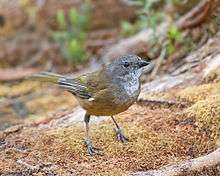Olive whistler
| Olive whistler | |
|---|---|
 | |
| Olive whistler, South West Tasmania | |
| Scientific classification | |
| Kingdom: | Animalia |
| Phylum: | Chordata |
| Class: | Aves |
| Order: | Passeriformes |
| Family: | Pachycephalidae |
| Genus: | Pachycephala |
| Species: | P. olivacea |
| Binomial name | |
| Pachycephala olivacea Vigors & Horsfield, 1827 | |
| Subspecies | |
|
see text | |
The olive whistler (Pachycephala olivacea) is a species of bird of the whistler family Pachycephalidae that is native to southeastern Australia. To an untrained eye, they can be mistaken for female golden whistlers.[2]
Description
Adult birds are around 18–20 cm (7–8 in) long, and have an overall olive brown plumage with a streaked white throat. The male has a dark grey head, pale grey breast and red-tinged buff belly and rump. The female lacks the red tinge, and has brown underparts. The legs, bill and eyes of both sexes are a brown-black. The melodious call has been likened to I'll wet you or you're cranky,[3] and is possibly the most musical of all whistlers.[4] It is predominantly insectivorous.
Subspecies
Five subspecies are recognized:[5]
- P. o. macphersoniana – White, HL, 1920: Found in eastern Australia
- P. o. olivacea – Vigors & Horsfield, 1827: Found in southeastern Australia
- P. o. bathychroa – Schodde & Mason, 1999: Found in southeastern Australia
- P. o. apatetes – Schodde & Mason, 1999: Found in Tasmania and islands in the Bass Strait, Australia
- P. o. hesperus – Schodde & Mason, 1999: Found in south Australia
Distribution
The olive whistler is found from the McPherson Range in far south east Queensland south through New South Wales and into Victoria and south eastern South Australia, Flinders and King Islands and Tasmania.[6]
Habitat
The habitat is mainly wet forest, and Antarctic beech (Nothofagus moorei) forest in northern New South Wales.
Status
An uncommon species, it is considered of least concern on the global IUCN Red List,[1] but vulnerable in New South Wales due to habitat fragmentation and feral cats and foxes.[4]
Reproduction
Olive whistlers nest from September to December, raising one brood during this period. The nest is a fragile bowl of twigs, grasses and bits of bark lined with softer plant material and bound with spiderwebs in the fork of a tree around 2 m (7 ft) above the ground. A clutch of two or three oval eggs are laid, 20 x 28 mm and shiny cream with brown, black and lavender spots and blotches (more on larger end).[6]
References
- 1 2 BirdLife International (2012). "Pachycephala olivacea". IUCN Red List of Threatened Species. Version 2013.2. International Union for Conservation of Nature. Retrieved 26 November 2013.
- ↑ Olive Whistler - Birds in Backyards
- ↑ Slater, Peter. A Field Guide to Australian Birds. 2: Passerines. Adelaide: Rigby. p. 190. ISBN 0-85179-813-6.
- 1 2 Department of Environment and Conservation, NSW (2005). "Olive Whistler - profile". Retrieved 15 May 2011.
- ↑ IOC v.6.3
- 1 2 Beruldsen, Gordon (2003). Australian Birds: Their Nests and Eggs. Kenmore Hills, Qld: self. p. 351. ISBN 0-646-42798-9.
